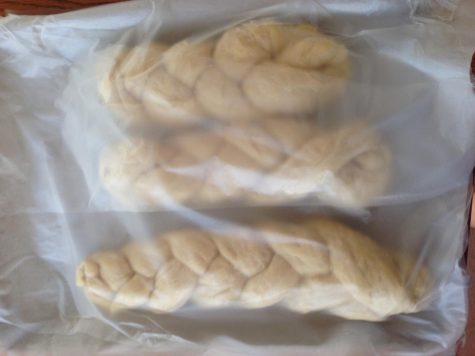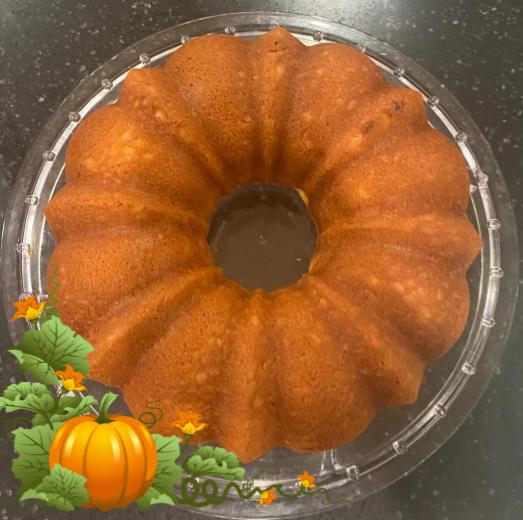Adventures in Baking: Challah
The finished challahs
One of my all-time favorite foods is challah, a traditional Jewish braided bread. It’s a delight to eat – it’s soft and flavorful, with a beautiful crust and a chewy texture. As a result, for this month’s recipe review I decided to make one of my first (and as of now, only) forays into bread-making by reviewing the Classic Challah recipe by Paula Shoyer in her cookbook, The Holiday Kosher Baker.
The first step in making yeast breads is to activate the yeast (if it’s active dry yeast, as required by this recipe). To do this, one dissolves the yeast in warm water between the temperatures of 100℉ and 110℉ before adding some sugar and letting the yeast sit and thicken. While the yeast sat, I mixed the oil, salt, sugar, boiling water, and cold water as instructed before combining the beaten eggs with the oil mixture. The yeast was then stirred into the dough before 6 cups of flour was added.
Finally, I got to the fun part: kneading! Breads must be worked, or kneaded, so as to develop their gluten structures, enabling a nice rise. I kneaded the challah dough for about 8 minutes, adding in the final cup of flour as I went, and decided the dough was ready to prove after successfully completing the windowpane test.
The windowpane test is a simple test that informs you whether or not a bread is ready to rise. One simply pulls off a small piece of dough and stretches it, and if it can be stretched so thin that one can see light through it (as if the bread is a window), then the bread is ready to be placed in a bowl to prove, or rise.
I proved the challah for one hour, and during that time the dough doubled in size, which informed that the yeast was working! Next, I shaped the dough into three braided loaves of roughly equal size before letting the lot rise a second time for 45 minutes. Finally, I brushed some beaten egg on each of the three loaves before baking for approximately 35 minutes. To check that they were indeed baked, I inserted a thermometer and measured the internal temperature. Since it reached 190℉, the generally recommended temperature that a bread must reach to be considered baked, I took them out of the oven and let them cool before tearing off a chunk to try.

Here are the challahs during their second prove

The baked challahs
At last, the challahs were finished! They smelled amazing and their crust was a deep, rich brown color. The insides were magnificently soft and it tasted fantastic! I wholeheartedly recommend this recipe and hope you all have fun baking your challahs!
Here is Paula Shoyer’s Classic Challah recipe from The Holiday Kosher Baker:
Ingredients:
- ½ ounce (2 envelopes; 14g) active dry yeast
- 1 teaspoon sugar, to activate the yeast
- ⅓ cup (80ml) warm water
- ½ cup (120ml) plus 1 teaspoon canola or vegetable oil, divided
- 1 tablespoon salt
- ¾ cup (150g) sugar
- 1 cup (240ml) boiling water
- ½ cup (120ml) cold water
- 3 large eggs
- 6½-7 cups (815-875g) bread flour
In a measuring cup, dissolve the yeast in the warm water. Add the teaspoon of sugar and mix. Let sit for 10 minutes, or until it thickens. In a large bowl, whisk together ½ cup (120ml) of the oil, the salt, and ¾ cup (150g) sugar. Add the boiling water and whisk again to dissolve the salt and sugar. Add the cold water and mix again.
Beat the eggs in a separate bowl and add to the oil mixture, reserving 1 tablespoon to brush on the loaves. When the yeast bubbles, add the yeast mixture to the bowl and stir.
Add 6 cups of the flour, 1 cup at a time, mixing the flour in completely after each addition. Place the dough on a floured surface and knead until smooth, adding flour a little at a time from the remaining cup of flour. The dough is done when you rub your palm across the dough and it feels soft. Shape the dough into a ball.
Add the remaining 1 teaspoon of oil to the bowl and rub all around the bowl and on top of the dough. Place the dough into the oiled bowl and cover with plastic wrap or a towel. Let rise 1 hour.
Divide the dough into 2 or 3 balls, depending whether you are making 2 or 3 loaves. Divide each ball into three pieces. Roll the pieces into long strands and then braid them. Place on a parchment-lined cookie sheet and let rise 45 minutes.
Preheat oven to 375℉ (190℃). Brush the tops and sides of the loaves with the reserved beaten egg with a teaspoon of water.
Bake for 35 minutes, or until the bread is golden.

Ellie is The Glen Bard's Editor-in-Chief and a senior at Glenbard West. This year is her third on the Editorial Board. She plays field hockey and chess,...





